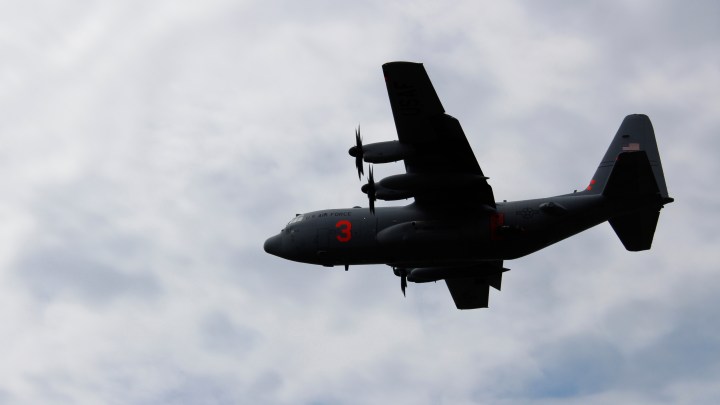
Crews train in Boise in case wildfires require military muscle
Crews train in Boise in case wildfires require military muscle

In Boise, Idaho, in late April, near the National Interagency Fire Center, a few planes were about to fly by: one smaller lead plane and a massive C-130 Hercules air tanker ready to drop thousands of gallons of water.
This training was for a special team of military personnel who will help fight wildfires if the Forest Service’s fleet of private contractors can’t meet the demand. The team is called MAFFS, which stands for Modular Airborne Firefighting Systems.
“We fly C-130 aircraft that are DOD assets — Department of Defense C-130s — that we can fly anywhere in the world, do low-level flying, airdrop missions, just hauling things from one point A to point B,” said Varun Purohit, a pilot and MAFFs commander in training.
According to the Forest Service, it budgets $2.5 million for the five days of training with about 400 participants.
Purohit said fighting wildfires isn’t a primary part of his job, but the MAFFS teams have been increasingly used in the last few years.
Forest Service and military personnel say that all eight MAFFS air tankers were deployed in 2020 and 2021. Last year was that group’s second busiest fire season in 49 years, including 96 days of military support for fighting fires.
This year is shaping up to be another extreme wildfire season in the southwest, so having this backup may be especially helpful.
MAFFS teams train to fight fires every year in Boise, home of the National Interagency Fire Center, but crews fly in from all over. The eight MAFFS tankers are based in Colorado Springs, Colorado; Cheyenne, Wyoming; Reno, Nevada; and near Oxnard, California.
Lt. Col. Purohit flew in from Cheyenne, where he works with the Wyoming Air National Guard. He said wildfires are often the most difficult missions they fly.
“We’re at high altitudes. It’s very hot,” he said. “You’re basically max-performing the aircraft. It is a challenge, but I think that’s kind of what makes it unique and maybe appealing in some ways.”
The challenge includes dropping these massive planes low and flying slow through heavy smoke, mountainous terrain and sometimes heavy air traffic.
It’s dangerous work.
Last year, an airtanker pilot from a private company died in northern Colorado while trying to help fight the Kruger Rock Fire at night — something that isn’t generally done because it’s so dangerous. A few years ago, two Idaho pilots died along the Utah-Nevada border fighting another large fire.
But Purohit said when he is fighting fires, he gets to see the direct effects of his work.
“We just dropped on the edge of the fire. That line held. We helped the guys on the ground do their job,” he said.
It’s not just pilots who came to train in Boise, though. There were also ground crews and flight engineers, like Chief Master Sgt. Cameron Pieters. He came up from Reno, where he’s part of the Nevada Air National Guard. He said engineers like him monitor all kinds of systems and make sure checklists are completed.
“They’re really the conscience of the crew. They bring adult supervision to the flight deck,” he said, smiling.

For Pieters, wildfire fighting does have its challenges.
“You may show up somewhere where the terrain is very rugged, where the smoke is very thick,” he said. “’Exciting’ is probably not the word I’d use. I’d use ‘spicy’ or ‘sporty.’”
This special MAFFs team is only called when there aren’t enough contractors for the Forest Service to tackle big wildfires. But if that happens, Pieters said this training will help ensure they’re ready.
“This is where we get to knock off the cobwebs, knock off the dust and make sure that we’re able to go out there and execute based on the level that the U.S. Forest Service needs us to do during fire season.”
There’s a lot happening in the world. Through it all, Marketplace is here for you.
You rely on Marketplace to break down the world’s events and tell you how it affects you in a fact-based, approachable way. We rely on your financial support to keep making that possible.
Your donation today powers the independent journalism that you rely on. For just $5/month, you can help sustain Marketplace so we can keep reporting on the things that matter to you.











